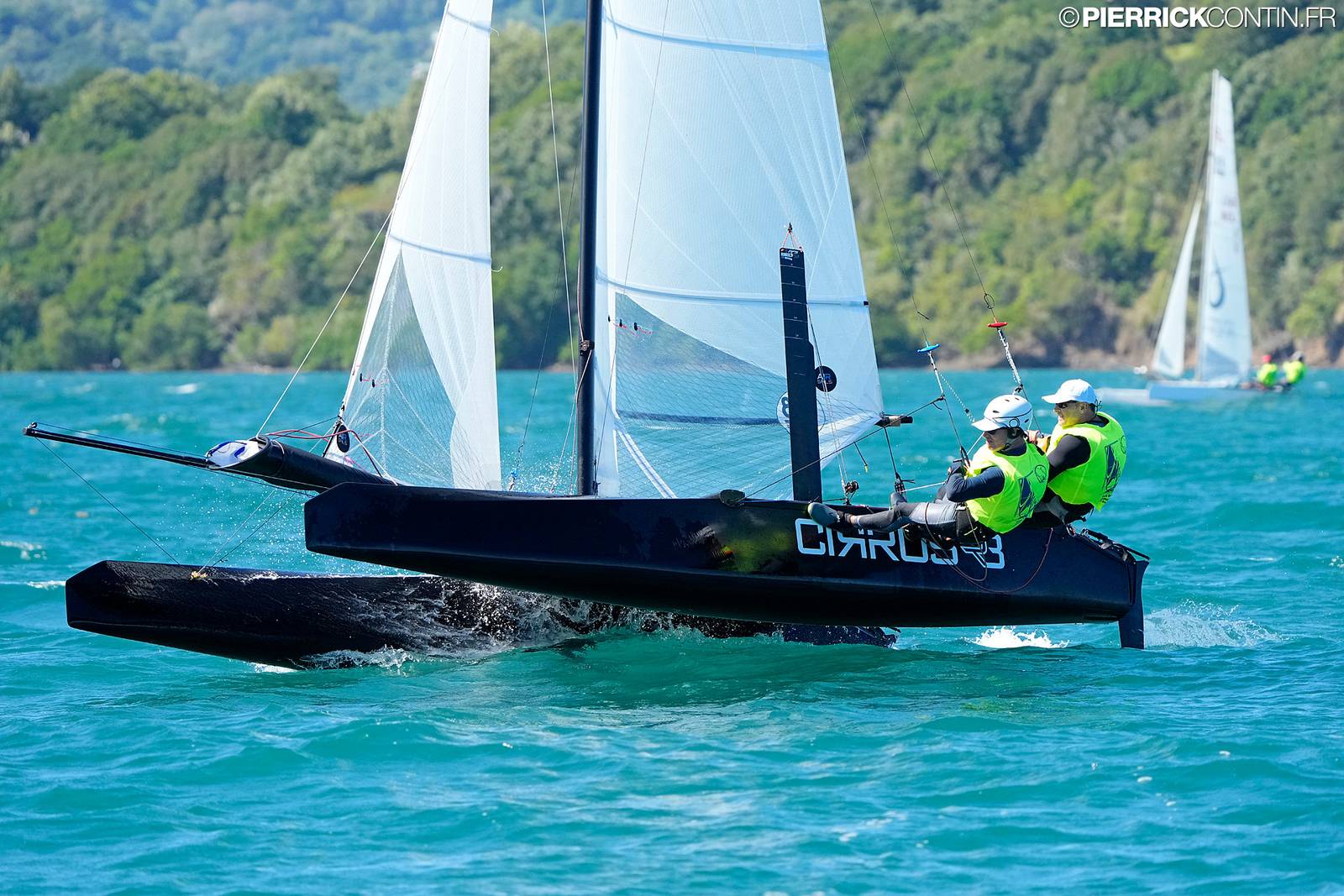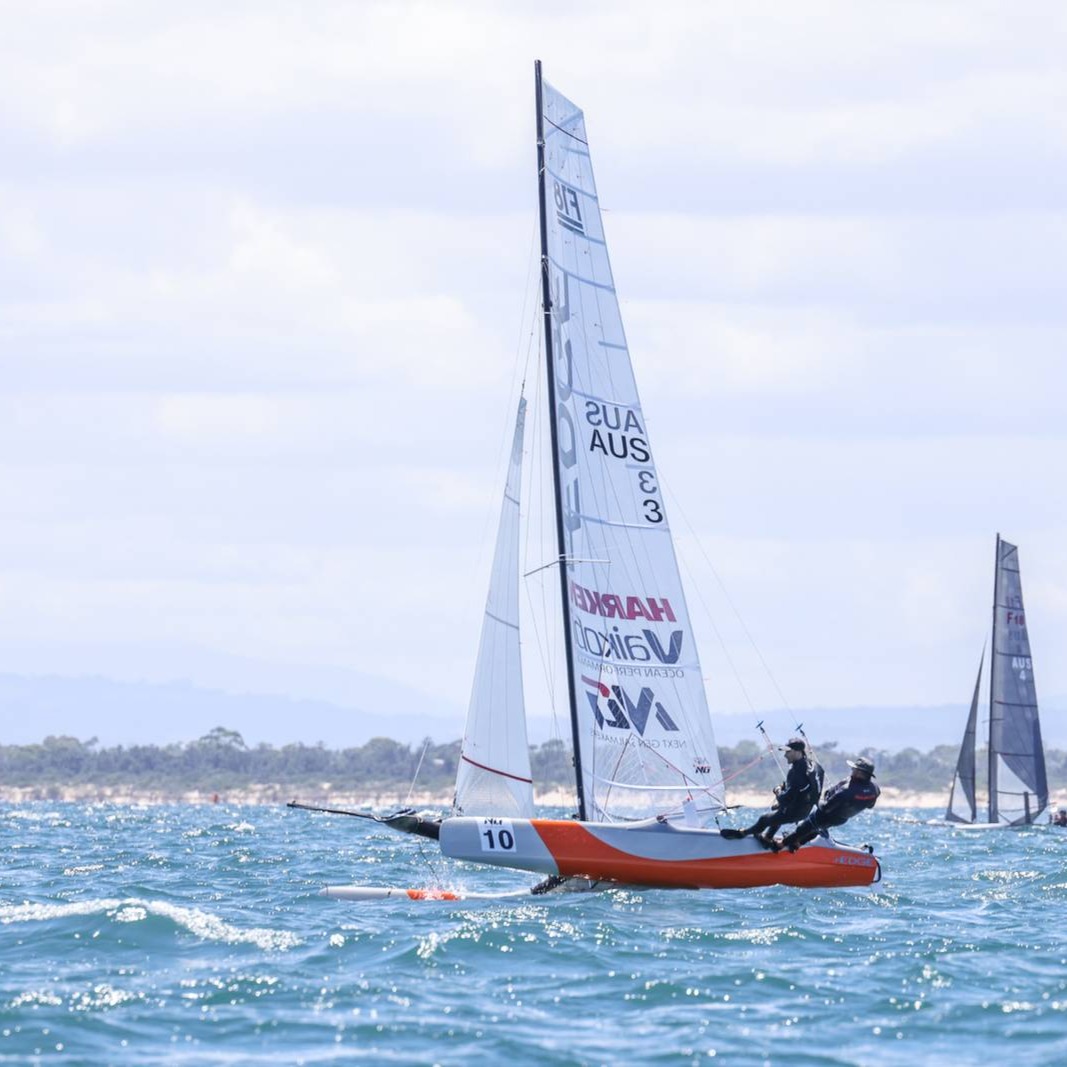Martin Fischer: Cats AC, Wildcat F18 Title & his new A-Class

A chat with Martin. For a full insight on Guru designer Martin Fischer (Capricorn, Wildcat, BOR90&Groupama foils and the list goes on…) check the previous interview we did some months ago here.
But read carefully this one, breaking news on some new A-Class cat(s) designed by him…
Also note he is working on several cat projects, but still available for the next AC72, the one team with his services will have an edge for next Cup on Cats.
To contact Martin Fischer: martin.ncl – gmail – com
Photo: Alex Udin & Martin Fischer
———————–
AC34
CSN- In the past interview we’ve made, I asked if you wanted to get involved in the AC 34, and if multis were the way to go. Now that the protocol has been released and Cats are on its way, what do you think of the preliminar data provided for the rule?
MF: Well, I think that’s excellent news!! So far no details about the
measurement rules have been published, but I like what I have seen so far.
CSN- Do cat wings can be designed like any other foil or sail? I mean does a naval architect or engineer has the tools and knowledge to develope them without having years of experience on the matter?
MF: I think in principal yes. In fact running a coupled CFD-structural
analysis of a soft sail is probably more complicated. It is quite difficult
to correctly simulate the flying shape of a soft sail. A rigid wing moves
far less and hence should be easier to be simulated on a computer.
CSN- Being a Box Rule similar to the F18, do you think there´s room for extreme different designs in platforms? (hulls , foils etc) or the designers will converge on a similar way the latest F18 hull shapes have reached?
MF: I reckon there might be some differences in hull shape and appendage
design, depending for which weather conditions a team will tailor their
boat. It seems that there will be some strict limits on the plan form of the
wing, so there will be little choice for that part. Beam and weight have to
be within strict limits which is a good thing since it determines the
righting moment and hence the power of the boats. I reckon that the
underwater appendages will become an important playfield.
CSN- Do you think more teams not usually involved with the AC may join now, like Groupama?
MF: It is a new rule and that should make it a bit easier for new teams so
this is a good opportunity for new teams to get into the game. Of course it
will be costly – Russell Coutts mentioned a price tag between 40 and 100
million Euros – but at least all teams start more or less from scratch.
Have you been contacted for an AC project? MF: So far I have not been contacted by any team and I have not contacted any team. Of course I am very interested to work on the design of these new
exciting boats.
CSN- Cats out of the Olympics but now in the AC, that I think it has even more exposure. How this will affect the multihull community (builders, designers, sailors) , to me is a milestone for cats historyMF: I agree with you. This is indeed a major change in sailing. The pinnacle
of our sport will be held in huge multihulls and that must have substantial
impact on the sport as a whole. Nowadays multihull racing takes only place
in beach catamarans, some off-shore racing in France, and soon the America’s
Cup. There is a huge gap in between. There is no such thing as a Melges-24,
a Farr-30 or a match racing circuit in multihulls. I think – and I hope –
that the decision to run the America’s Cup in big catamarans will encourage
multihull racing activities in the mid-size range.
– How’s the Groupama V70 project going ? Already won the 1st event
MF: The progress of the project is good, but I won’t go into details.
CSN-After some intensive design , testing, and tuning hours the Wildcat clinched the title in its 2nd year after built, with Olivier and Arnaud, you were also involved with the Sail Innovation project. The feedback that I got from the Arg crews at Erquy is that they were ahead of the competition, that they could ride one on one with the others but Olivier was in another league in speed and pointing ability. –You knew beforehand that they had an edge over the rest, or it was a good surprise?MF: No, I did not know it beforehand. It was clear that they were really
quick, and that was not by accident. The boat was extremely well prepared by
Alex Udin. He developed the sails, but he also took care of all the detail
on the boat.
Olivier and Arnaud put a lot of effort and a lot of talent into this
project. They did quite a bit of training and they knew that they were very
competitive. That was in my opinion a very important point. If you know that
you are quick there is no need to take big risks – and that is what they
did. They perfectly managed their Worlds and fortunately won convincingly,
despite some pressure.
A-Class
CSN-How’s your flying A-Class going?
MF: We are progressing very well. Olivier Schaller, a good friend of mine in
New Caledonia and an excellent boat builder is in charge of building the
boat. The two hulls, the rudders and the mast are built and the foils are
under construction. The moulds for all components (rudder castings, foil
cases, …) are built and other components like beams, rigging, etc have
been ordered and are on their way to New Caledonia. The sail will come from
Alex Udin. I hope to launch the boat at the end of October. This is a bit
behind schedule, but New Caledonia is quite remote, which causes regularly
some delay.
Did you see the new DNA design? Shape is taken from Alinghi 5. One of the things I like more of that A-Cat is the overall volume, that it seemed not to affect it in low winds and gives margin in harsh conditions – The F18 has gone this way and now the A-Class, the new AC72 will maintain this trend? clearly they should improve Alinghi’s shape for a more stable ride..
MF: I saw photos of the new DNA A-Cat. I like the boat and it seems indeed
to follow the same path that was chosen in the F18.
As of the AC72 the hulls surely will be proportionally narrower than an
A-Class, simply due to the scale effects. As I mentioned above I think the
appendages on the AC72 will play a very important role and that will
obviously influence the shape and the volume of the hulls.
CSN-Tell us about the ongoing status of your projects:
MF: I am working for Groupama as a member of their design team for their
Volvo-70 project. Beside that I am following the final stage of the
construction of a 40-ft racing trimaran that I designed together with Benoit
Cabaret and that is under construction in New Caledonia. Furthermore I am
working on a new A-Class design for a customer in Europe and I am working on
pre-studies for a 30 foot lake racer (catamaran) and for a 30 foot coastal
racing catamaran. I think that the AC72 will boost the activities in this
mid-size catamaran sector.
——–
Copyright Catamaran Racing News, & Design
To contact Martin Fischer: martin.ncl – gmail – com




























I just heard that my great sailing friend and former CEO of Hobiecat Europe has passed. May The endless oceans…
...Report was sent by an F18 Sailor, if you want Hobies reported send your own, we'll publish as usual. Cheers.
Looks like in your report the Hobies are not really present. Suggest to rewrite the article.
Thanks for the great report Wik. Great battle.
If I correctly read the results the overall winner this year is a Hobie16